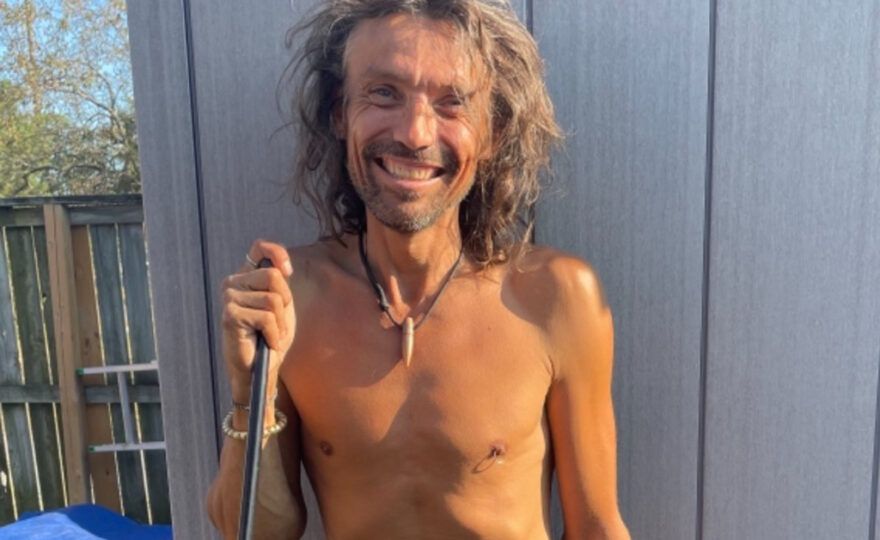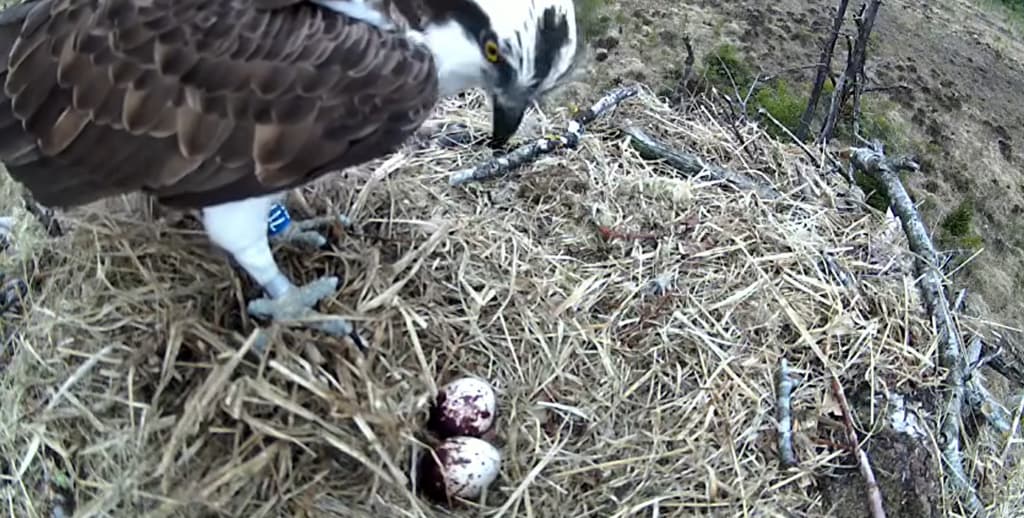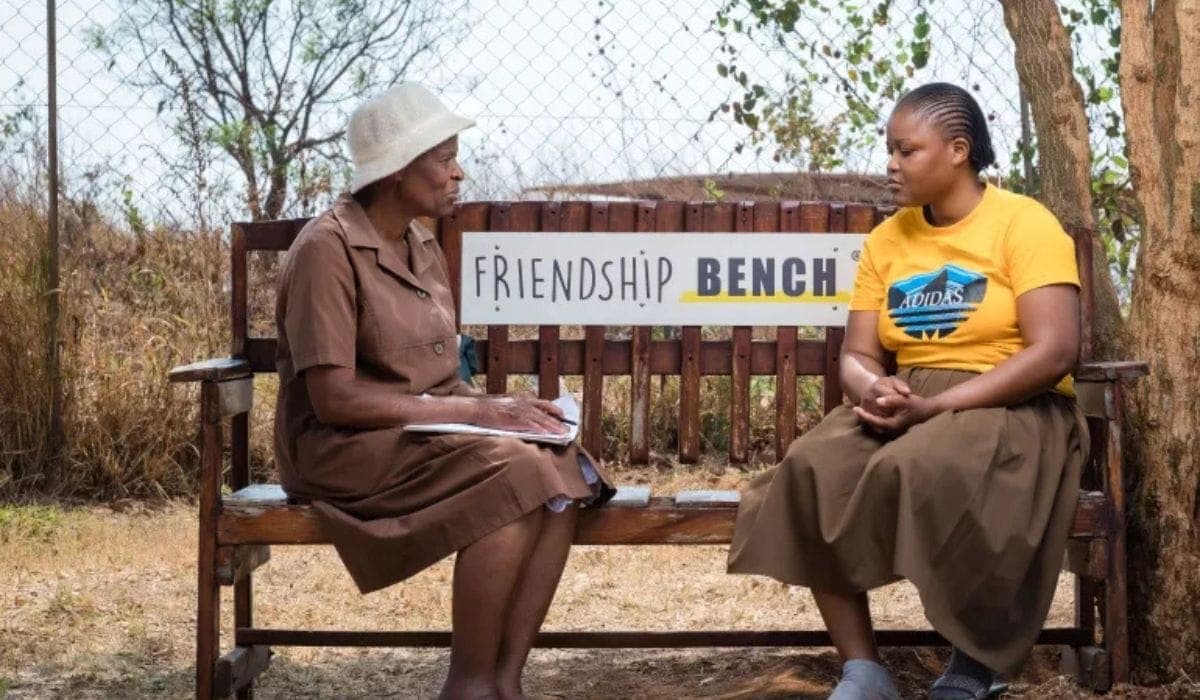
Living
Bringing the Homeless Closer to Home
David McDonald as well as Kim Cornier are not, at first blush, two individuals people would connect as neighbors. As folks often judge others so quickly on sight, the two immediately seem to live worlds apart. Yet, ironically, David was Kim’s neighbor literally in her backyard. And as Kim puts it, she would not have preferred things any different.
The two very different people crossed paths in July, which set them on their fate from that point forward. David McDonald had, at least for the last five years, been verifiably homeless most of his time. However, here and there he would manage to get an advantage that would make things easier from day to day. One of those advantages which began to fail was an e-scooter he was riding for basic transportation when it blew a tire passing by near where Kim Cormier lived. Kim happened to be outside at the time working on a project with her laptop, and David took the chance to ask for a simple favor – would she watch his belongings while he tried to go find a replacement inner tube to fix his scooter. Being homeless on the street meant dealing with things being stolen all the time, so unless items were watched continuously, they had a habit among the homeless to get up and disappear.
Eventually, David returned, and Kim felt comfortable enough to ask David if he wanted to have dinner with Kim and her partner, Andrew. The invitation was a hit. The three people ended up having a great evening, lots of conversation, and most importantly connecting on a basic human level. There was also a hell of a lot of laughing, which is good for anyone in any situation.
For David, the evening was finally a nice break. He had been on a bad run of horrible luck that just seemed to be getting worse by the day. Prior to getting stuck in the homeless cycle, he had up until 2010 been a very comfortable owner of a gas station that earned David a six-figure income annually. However, as most in the consumer fuel business know, the profit margins are thin and money is made on volume only. When gas prices increased, people stopped filling up as much. The loss of volume and cut in gross sales literally swung David’s business from being in the black instead to sinking in the red. Eventually, the gas station failed and David lost everything trying to hold on. Then, with no income, he lost is home and finally his car. It didn’t help that a personal relationship failed during this time as well. When it rains it pours, but none of that rain was anything useful for David. Everything David knew disappeared in front of him within a year.
Eventually, David tried his luck again in Toronto, but when his daughter moved out on her own, David had no ties to the area and nothing to support him. So, he tried his luck out west, moving to Vancouver by Greyhound bus. It was a mistake, and the former business owner was quickly homeless. Somehow, trying to find something better, David took nine entire months to walk and bike his way back to Ontario. Finally, he found a makeshift home site in a park in Toronto, still homeless. There were moments for a few days or weeks where David was able to sleep on a couch or stay with friends, but it always came back to living on the street. Nothing would gel out.
David tried his hand a few times being a roommate, but he was frequently threatened and robbed by his own flatmates, oftentimes because his sexual preference as a gay man gave the impression of him being a weak target. Right after the tire blowout near Kim’s home, David was back on the street, feeling safer there than with roommates. Ironically, David would refuse to use homeless services frequently because he felt there were folks worse off than him who needed the money more.
Once she heard his story, Kim and her partner felt moved to do something about it. They decided to let David camp in their backyard. He would pitch his tent, be safe, and have a stable location to try to build from. And that started a friendship where David and Kim both blame the other as being the better person in their connection. That has since blossomed into a project that will now provide David a microhome, fully insulated, as a place to live and a replacement for his tent living. But for Kim and her partner, he’s not the homeless guy in their backyard; David is family now. And to David, Kim and her partner are angels when he needed help the most.
Living
New Osprey Couple Lay First Eggs at Foulshaw Moss Nature Reserve

A young osprey pair has laid their first eggs at Foulshaw Moss Nature Reserve in South Cumbria, bringing new excitement to the reserve’s thriving birdwatching scene.
The pair, male Blue 476 and female Blue 717, first paired up in late April at a second nest on the reserve, near Grange-over-Sands. According to Cumbria Wildlife Trust, which manages the site, Blue 476 is a “local lad,” hatched in 2021 at a private site in the Lake District. Blue 717, meanwhile, is thought to be from Fife, having hatched in 2022.
Young and Hopeful Parents
This is the pair’s first nesting attempt, and they’ve laid two eggs so far. The Trust noted the eggs came a bit late in the season, and since the parents are inexperienced, hatching success isn’t guaranteed. Still, staff remain hopeful and are closely monitoring their progress.
Ospreys typically share incubation duties, which last around 37 days. During this time, the adults take turns incubating the eggs, maintaining the nest, fishing, and defending their territory from potential intruders.
Nest Rivalry
Foulshaw Moss is already home to a well-established osprey pair, Blue 35 and White YW, who have nested at the site for over a decade. The long-time residents are also incubating eggs, expected to hatch around May 23. Some interaction has been observed between the two pairs: in late April, Blue 476 approached the original nest, only to be swiftly chased off by Blue 35.
Visiting the Reserve
Visitors are welcome at the reserve to try and spot the ospreys, though they’re reminded to plan ahead. The car park is small and fills up quickly, and the access road is narrow with no passing places. Bike racks are available, and the site is reachable via public transport.
While the second nest doesn’t yet have a live webcam, the Trust has installed a new viewing hide on the eastern side of the reserve, offering improved opportunities for osprey watching. A volunteer is often on site with a telescope and may be able to help visitors spot the birds. For those viewing from a distance, binoculars are strongly recommended.
The original nest, home to Blue 35 and White YW, is viewable through the Foulshaw Osprey Webcam, funded by public donations.
Osprey Fast Facts
- Ospreys (Pandion haliaetus) are large fish-eating raptors with a wingspan of about 5 to 6 feet.
- They migrate thousands of miles each year, wintering in West Africa or southern Europe and returning to the UK in spring to breed.
- The same nesting sites are often reused year after year, with some osprey pairs returning to the same nest for over a decade.
- Chicks are ringed before fledging so their movements and survival can be monitored as part of ongoing conservation efforts.
- Ospreys became extinct in England by 1916 due to egg-collecting and persecution but have made a steady comeback thanks to reintroduction efforts and legal protections.
Despite a few heartbreaks over the years—such as unhatched eggs and lost chicks—the success of Foulshaw Moss as a breeding site underscores the resilience and return of this iconic bird to the region.
Living
Teen Trio Builds Salt-Powered Fridge to Deliver Lifesaving Vaccines Without Electricity

Three teens from Indore, India, have created a salt-powered mini refrigerator that works without electricity—an innovation that could transform how medical supplies reach remote communities.
Their invention, called Thermavault, uses a chemical process where salts absorb heat as they dissolve in water, effectively cooling the surrounding area. It’s designed to maintain safe storage temperatures for vaccines, medications, and even transplant organs—all without needing to plug in.
The creators—Dhruv Chaudhary, Mithran Ladhania, and Mridul Jain—were inspired by challenges their parents, all in the medical field, experienced during the COVID-19 pandemic. Getting vaccines to rural areas without reliable electricity was an uphill battle. So, the three teens got to work.
After experimenting with nearly 150 different salts and hitting several dead ends, a teacher’s suggestion led them to two that worked: ammonium chloride and barium hydroxide octahydrate. Ammonium chloride kept temperatures between 2°C and 6°C—ideal for many vaccines—while the second salt combo could bring temps below freezing, suitable for more sensitive materials.
Their salt-based cooling system is housed in a compact insulated box lined with copper. The solution is poured into the walls, which then pull heat away from the contents inside. Better still, the system is reusable: simply boil off the water in the field to reclaim the salt for future use, no freezer or power supply needed.
Their innovation earned them the 2025 Earth Prize for Asia and a $12,500 award. The trio plans to use the funds to build 200 Thermavault units for 120 hospitals. They’re also working toward World Health Organization certification so they can partner with organizations like Gavi, which delivers vaccines around the globe.
Dr. Pritesh Vyas, an orthopedic surgeon who tested Thermavault in a local hospital, confirmed that it kept vaccines stable for up to 12 hours. With further upgrades like a built-in temperature monitor, he believes it could become a critical tool for rural healthcare.
For now, the teens are focused on refining their device and taking it to the global stage. As voting opens for the Earth Prize’s global winner on April 22, Thermavault has a chance to gain even more attention—and potentially save countless lives.
Living
Texas Mom Welcomes Third Baby at 51 — and Says She Might Not Be Done Yet

Grace Collins, a mom from Texas, isn’t letting age define her motherhood journey. At 51, she recently welcomed her third child — a baby boy named A.J. — and says she’s not sure she’s finished growing her family just yet.
Collins first gained attention in 2024 when she went viral on TikTok for sharing her story of becoming a mom later in life through IVF. Her journey began at age 44 with the birth of her first daughter, Maggie. Two years later came her second daughter, Goldie. And in 2024, at age 50, she became pregnant again — this time with her first son.
“It’s hard being pregnant no matter what age you’re at,” Collins told TODAY.com. “And I don’t know if I’m done either!”
Though being pregnant in her 50s might seem daunting, Collins says it’s actually gotten easier over time. “I felt like I was more tired when I was pregnant at 44 than I was when I was 50,” she previously told PEOPLE. “Maybe my body just figured out how to cope, or maybe having children keeps me young.”
That sense of energy seems to carry into her everyday life as a mom of three little ones. “I’m a pretty on-the-go kind of girl,” she said. “I’ve been in the little kid daily grind since I was 44, so I don’t know any different.”
Collins also shared that age has brought some unexpected advantages. With more life experience under her belt, she feels more aware of her body and committed to her health. Before her last pregnancy, she took proactive steps to ensure she was in good shape, including a full slate of medical screenings and maintaining an active lifestyle.
“I made sure I had a healthy baseline,” she told PEOPLE. “All my pregnancies have had their hurdles — but overall, I can honestly say it’s become easier with each one.”
Despite being older than many of the parents she meets at playdates or school events, Collins says age isn’t a barrier when it comes to connecting. “The things we have in common outweigh our age differences,” she said. “If anything, having kids has honestly kept me younger.”
As for whether baby A.J. will be her last? Collins isn’t closing that door just yet. For now, she’s savoring life as a busy mom and embracing every moment. “I’m going to do everything I can to stay young and present — not just for my kids but for myself.”
Living
Friendship Benches Come to Sussex, Offering Free Mental Health Support Inspired by Zimbabwe

A simple wooden bench may seem unremarkable, but in Sussex, it’s about to become a powerful tool for tackling mental health challenges.
A pilot scheme called the Friendship Bench, originally developed in Zimbabwe, is launching in Sussex to provide free, low-barrier support for people dealing with depression, anxiety, and loneliness. The initiative places trained lay counsellors—affectionately called “grandmothers” and “grandfathers”—on benches in public indoor spaces like libraries and community centers, where they offer compassionate, non-judgmental conversation to anyone who stops by.
Founded in 2006 by psychiatrist Professor Dixon Chibanda, the Friendship Bench model was born from the idea that everyday people, especially older members of the community, can offer meaningful support. Despite receiving just two weeks of training, the lay counsellors have made a global impact. Studies, including one published in The Journal of the American Medical Association, show the program led to an 80% reduction in depression and suicidal thoughts, and a 60% improvement in quality of life among participants.
Now brought to the UK by Dr. Nina Lockwood of Brighton and Sussex Medical School, the Sussex pilot will involve ten lay mental-health workers offering six-to-eight-week support sessions. Unlike the original Zimbabwe benches that are placed outdoors, the UK’s version will adapt to the British climate with indoor seating areas.
“There is an unintended novelty to the west taking a model founded in Africa,” Lockwood said. “But just like in Zimbabwe, the UK has a massive shortfall in mental health resources compared to the demand of our population’s mental health problems. We urgently need to adopt agile, alternative ways of working.”
Trained volunteer Mebrak Ghebreweldi, from Diversity Resource International, said the approach allows time to uncover root issues, like housing insecurity or unemployment—problems that can be missed in rushed GP visits.
“GPs don’t have time for those long conversations,” Ghebreweldi explained. “They’ll just prescribe something. But when we listen, we often find that what seems like depression may actually stem from practical, solvable problems.”
Chibanda’s vision for the Friendship Bench grew from a recognition that medication and diagnoses alone can’t fix a growing global mental health crisis. “Not everyone can see a mental health professional,” he said. “But most people have access to the care, compassion, and wisdom of grandmothers—the unsung heroines of the world.”
In the UK, mental health needs are urgent. One in six adults reported moderate to severe depressive symptoms in 2022, and NHS wait times for therapy can stretch over four months. The Friendship Bench offers a hopeful alternative—one built on human connection and community.
With over half a million people already helped worldwide, the scheme’s expansion into Sussex could be a quiet revolution in how we approach mental wellness—one chat at a time.
Living
New Coral Feeding Device Offers Hope for Reef Restoration

A team of scientists from The Ohio State University has unveiled a groundbreaking device designed to enhance food sources for coral reefs, offering a potential boost to restoration efforts. The device, called the Underwater Zooplankton Enhancement Light Array (UZELA), works by attracting zooplankton to coral habitats, increasing their availability as a food source.
UZELA is a submersible, programmable light capable of operating for up to six months on a single battery. When maintenance is needed, trained divers can perform simple servicing. The device activates for roughly an hour each night, emitting a specific type of light that encourages zooplankton accumulation without disturbing other marine species. This process enhances the feeding opportunities for corals, improving their chances of survival and growth.
Encouraging Results from Initial Tests
Researchers tested UZELA near two native Hawaiian coral species, Montipora capitata and Porites compressa. Their observations showed a seven-fold increase in local zooplankton populations and a dramatic improvement in coral feeding rates—ranging from 10 to 50 times higher than usual. These findings were published in Limnology and Oceanography: Methods.
According to study lead Andréa Grottoli, a professor of earth sciences at The Ohio State University, coral reefs play a disproportionately important role in marine ecosystems. “Although reefs make up less than 1% of the ocean, they support a third of all marine life,” she explained. “With increasing threats, we must find ways to protect them.”
The Growing Threat of Coral Bleaching
Extreme ocean temperatures continue to endanger coral reefs. The U.S. National Oceanic and Atmospheric Administration (NOAA) recently reported that from February 2023 to April 2024, nearly 60.5% of the world’s coral experienced bleaching. This occurs when corals expel the algae that provide them with essential nutrients, making them more susceptible to disease and die-off.
While corals can recover if water conditions stabilize, many struggle due to a lack of available food. The presence of concentrated zooplankton, as facilitated by UZELA, could help mitigate some of the negative effects and provide corals with the nutrition they need to survive.
A Short-Term Solution with Long-Term Potential
Although UZELA is not a permanent fix for coral degradation, researchers see it as a valuable tool for temporary relief. Grottoli compared it to “a band-aid that could help buy us time” while broader solutions, like reducing carbon emissions, are pursued.
Currently, UZELA devices are assembled by hand, but researchers are working with a local engineering firm to refine the design for mass production. If successful, an improved version could be ready within the next few years, allowing for expanded deployment in vulnerable coral reef regions.
“Addressing climate change is the only way to truly save coral reefs,” Grottoli emphasized. “But tools like UZELA give us a fighting chance to protect some reefs while we work toward a more sustainable future.”
-

 OMG7 years ago
OMG7 years agoA Couple Gave Birth to the Most Beautiful Twins Ever
-

 OMG8 years ago
OMG8 years ago20 Rare Historical Photos
-

 OMG7 years ago
OMG7 years agoHilarious Airport Photos
-

 Cute7 years ago
Cute7 years agoMom Refuses to Let Daughter Eat Sugar and Years Later This is What She Grows Into
-

 OMG7 years ago
OMG7 years agoTop Secret Air Force One Facts That You Never Knew
-
OMG7 years ago
The Funniest Yearbook Photos Of All Time
-

 OMG7 years ago
OMG7 years agoRetired Mathematician Restores Log Cabin
-

 OMG6 years ago
OMG6 years agoWhat Happened When This ‘Duck Dynasty’ Legend Chopped Off His Beard?